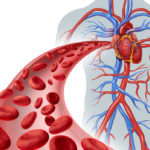The aortic and mitral valves are most commonly affected because they are subjected to high pressure. The tricuspid and pulmonary valves, which work in the low-pressure side of the heart, are less commonly involved. Two types of problem may affect heart valves: stenosis and regurgitation.
- “Stenosis” means a narrowing or a stiffness of the valve that restricts blood flow through it. Aortic-valve stenosis makes the heart work harder, so it becomes thickened (hypertrophied). This thickening of the left ventricle may lead to permanent damage if the valve is not corrected. In mitral valve stenosis, the left ventricle does not fill properly, and blood backs up into the lungs.
- “Regurgitation” (also called insufficiency, incompetence or leakage) is due to failure of the valve to close properly, which allows blood to flow backwards. This means that the ventricle has to pump much more blood with each beat. This eventually causes the ventricle to enlarge or dilate, so that the muscle becomes stretched and thickened. Once the heart becomes over-stretched, recovery of normal function is less likely, even after the valve is repaired or replaced.
Heart Valve Disease’s Symptoms
Symptoms due to aortic valve stenosis occur when the left ventricle:
- can no longer pump enough blood through the narrowed valve, causing light headedness or black outs
- becomes so thick that its demand for oxygen exceeds its blood supply, causing pain like angina.
In aortic-valve regurgitation, symptoms may only occur after heart dilatation has become severe. The main symptom is shortness of breath. For a long time, the heart can compensate for a faulty valve. The appearance of symptoms means that the heart’s compensating mechanisms are no longer sufficient, and the heart is starting to fail. Therefore, symptoms can happen quite late in the course of development of valve disease.
Anyone with evidence of valve disease, even if without symptoms, should have tests to determine the degree of valve malfunction and its effects on the heart. This is done primarily by clinical examination, echocardiography, ECG and chest X-ray examination. The aim is to determine the best time to operate, preferably before the effects on the heart have become irreversible.



